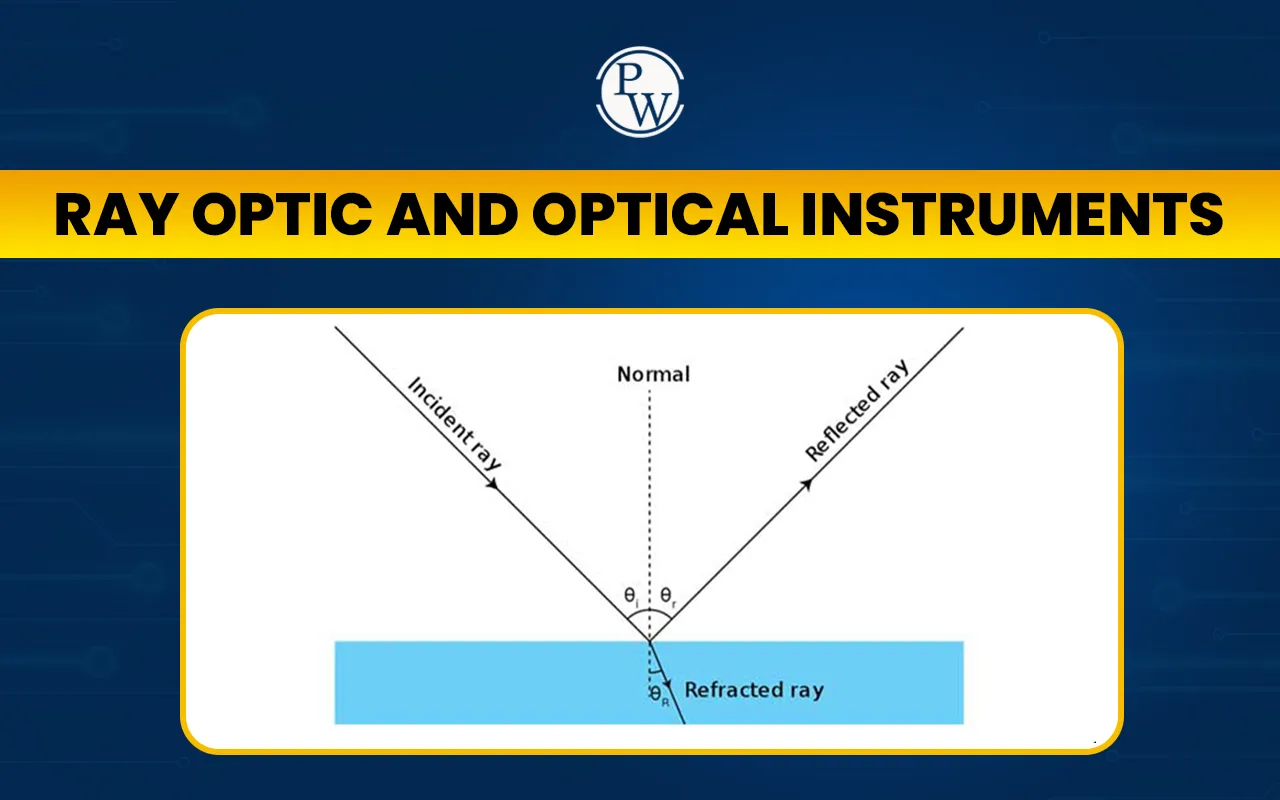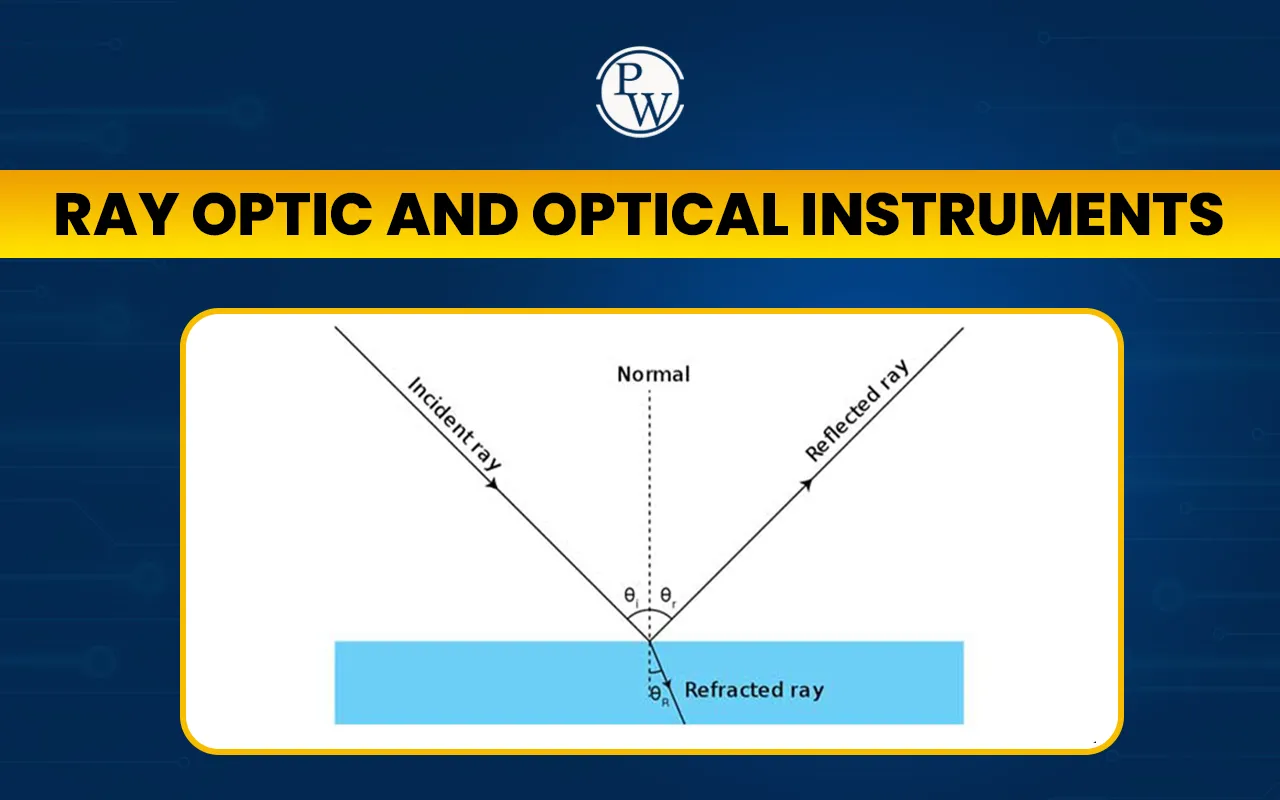

Ray optics and optical instruments are significant portions of NEET Physics as they cover around 6% of the total exam weightage. This physics chapter involves the study of light travelling in a straight line, and its interaction with various mirrors, lenses, and prisms. It also discusses how the ray optics principles are used in daily life optical instruments such as microscopes, telescopes, and cameras.
Ray optics mainly includes the topics such as laws of reflection, refraction, image formation by mirrors and lenses, and their practical applications. It also connects the theoretical aspects of physics to real-life applications, such as vision correction, magnification, and imaging devices. Students preparing for NEET should thoroughly study and understand all the concepts and their basic formulae and derivations to solve numerical questions correctly.
What are Ray Optics and Optical Instruments?
Ray Optics, also known as geometrical optics, is the study of light propagation in terms of rays. A ray is an idealized model of light that travels in a straight line and undergoes reflection and refraction at the boundaries of different media. Ray optics can be used to describe the formation of images by mirrors and lenses, the refraction of light by prisms, the total internal reflection of light, and many other phenomena.
Optical Instruments are devices that utilize the principles of ray optics to form images or magnify the objects that are too small or too distant to be seen clearly by the naked eye. Some common examples of optical instruments are the microscope, the telescope, the camera, and the human eye.
So, Ray Optics and Optical Instruments are the two interrelated fields that deal with the behavior of light as rays and the devices that use light rays to produce visual effects.
Also Check: Ray Optics and Optical Instruments NEET Notes
Laws of Reflection and Refraction
Refraction and reflection are the processes by which light rays change their direction.
Reflection
A light ray which falls on a polished surface like a mirror, undergoes reflection and retraces back into the same medium, obeying the laws of reflection as follows:
1. The angle of incidence i is equal to the angle of reflection r.
2. The incident ray, the reflected ray and the normal at the point of incidence, lie in the same plane.
Refraction
Refraction is a process by which the light ray is partially transmitted into the second medium when it travels from one medium to another. It bends because of the change in speed. The laws of refraction are:
1. The incident ray, the refracted ray and the normal, all lie in the same plane.
2. The ratio of sine of angle of incidence to sine of angle of refraction is a constant for two media and it is called Snell’s Law.
sin i / sin r = μ₂ / μ₁ = n₁₂
This is called the refractive index of the second medium with respect to the first medium.
Refraction Through a Plane Surface
A ray of light changes direction twice on passing through a plane glass slab. However, it finally travels in a direction parallel to the incident ray, although laterally displaced from it.
On emerging from a glass slab into air, a ray of light may have the same lateral displacement at each point of the cross-section. This requires that the glass-air interfaces be parallel, that the entering and emergent rays be in the same medium, and that the angles of incidence and emergence are equal.
In the case where a ray of light travels from air (or vacuum) to glass of refractive index μ₂ and then from glass to air, its lateral displacement (d) after refraction through the glass slab of thickness t would depend on the angle of incidence. Glass windows and lenses of optical instruments are explained on the basis of this principle.
Also Check: Ray Optics and Optical Instruments MCQs
Refraction Through a Spherical Surface
The spherical surface is either a convex or concave portion of a sphere.
Refraction of light rays take place at a spherical surface as light travels from one medium to another medium resulting in real and virtual images.
The formula for refraction at a spherical surface when object distance is u, image distance v and R is the radius of curvature is:
(n₂/v) – (n₁/u) = (n₂ – n₁)/R
It is used to find the position of the image formed by curved surfaces. This formula is also used to derive the formula for lenses and mirrors.
Mirror Formula and Magnification
A mirror forms an image because of the reflection of light from the mirror. The mirror formula is given by;
1f=1u+1v [ u=object distance ,v=image distance,f=focal length of mirror]
Magnification produced by a mirror is given by:
m= –v/u
A concave mirror forms real or virtual image according to the position of the object, but a convex mirror always forms a virtual, erect, and diminished image.
Magnification gives the idea about the size of the image in comparison to the size of the object.
Lens Maker’s Formula and Its Derivation
A lens is formed by the combination of two refracting surfaces. The derivation of lens maker’s formula is based on the refraction through two spherical surfaces.
Formula: 1/f = (μ – 1)(1/R₁ – 1/R₂)
Where, f = focal length of the lens μ = refractive index of lens material R₁ and R₂ = Radii of curvature of two surfaces of a lens.
Lens maker’s formula can be used for designing lenses of required focal length for the optical instruments such as camera, microscope, spectacles, etc.
Refraction Through a Prism and Formula
Light passing through a prism bends twice. Once when entering, the other when leaving the prism. Due to this deviation, the bending of light is termed as dispersion of light, with dispersion splitting white light into seven constituent colors.
Angle of deviation (δ) when angle of incidence is small is:
δ = (μ – 1)A
Where,
A = angle of prism
μ = refractive index of the material of prism
When the ray passes symmetrically through the prism, the angle of deviation is the least. This property is utilized in spectrometers and many optical experiments.
Also Check: Ray Optics and Optical Instruments Important Questions
Concept of Total Internal Reflection
When a light ray in going from a denser to a rarer medium, it bends away from the normal. If the angle of incidence is greater than a certain value, then the light ray suffers total internal reflection.
Condition for TIR is:
-
The ray of light should be going from a denser to a rarer medium.
-
The angle of incidence should be greater than the critical angle (C).
-
C can be calculated using the formula:
sin C = 1/μ
Optical fibers, sparkle of diamonds and Periscopes, take advantage of multiple reflections without loss of light rays.
Optical Instruments and Their Applications
Optical instruments are those in which lenses/mirrors/prisms are used for the formation and examination of images. The construction and working of optical instruments are based on the laws of reflection and refraction. Some commonly used Optical Instruments are as follows:
-
Human Eye: The human eye is a natural optical system which we use for the sense of vision.
-
Camera: A Camera is an optical instrument which works just like a human eye. The image formed by the camera on the film/sensor is a real image.
-
Microscope: It is an optical instrument which is used for the observation of small objects.
-
Telescope: An optical instrument used for the observation of distant objects such as stars and planets.
-
Spectrometer: An optical instrument used for the study of dispersion and refractive index.
-
Each of these instruments use one or more of the concepts of ray optics like lens maker’s formula, mirror formula, formula of refraction through prism, etc.
Magnification in Microscope and Telescope
Microscope and telescope are two important optical instruments that work on the principle of refraction through lenses. Both are used to observe objects that cannot be seen clearly with the naked eye, but their working purposes are different.
Microscope
An image highly magnified image of a small object is obtained by using a microscope. The microscope has two convex lenses, one called objective and another called eyepiece.
Total magnification of the image is M = M₁ × M₂ = (L / f₀)(D / fₑ)
where
L = length of microscope tube
f₀ = focal length of objective
fₑ = focal length of eyepiece
D = least distance of distinct vision (usually 25 cm).
Telescope
A telescope is an instrument used to see far away objects. Telescope also uses two lenses; objective and eyepiece. Angular magnification produced by telescope is:
M = f₀ / fₑ
Microscopes and telescopes work on the principle of refraction at lenses and image formation principles discussed in the topic Ray optics.
Power of Combination of Lenses
When two or more lenses are placed near each other their combined power determines their converging or diverging action.
Power of lens combination is given by,
P = P₁ + P₂ + P₃ …….
Where, P₁, P₂, and P₃ are the individual powers of lenses.
Since power (P) = 1/f (in meter) thus, we can easily calculate their effective focal length. This concept is utilized in the design of a compound microscope and spectacles to correct vision defects.
Ray Optics and Optical Instruments PDF
Candidates appearing for the NEET Physics exam are often in search of a complete and lucid overview chapter of Ray Optics and Optical Instruments. The topic is a part of the NEET Physics syllabus, with a weightage of around 6% in the exam.
Students who are looking for a proper conceptual understanding can easily download the PDF file of Ray Optics and Optical Instruments from here. The PDF contains detailed explanations of all important topics, formulas and concepts to help students in strengthening their preparation.
Also Check:
- NEET Exam Pattern 2026
- NEET 2026 Admit Card
- NEET Eligibility Criteria 2026
- NEET 2026 Exam Centres
- NEET Candidate Login 2026
Candidates can easily go through the laws of reflection and refraction, mirror and lens formulas, optical instruments, applications, and much more in a simplified and well-structured way — a must for NEET revision.
Download Ray Optics and Optical Instruments PDF
Prepare for NEET with PW Online NEET Coaching! Our courses offer structured lessons, clear explanations of concepts, and interactive classes to support your NEET preparation effectively.
